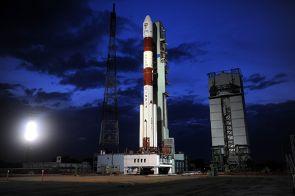 | « Back to article | Print this article |
 In a landmark late Monday night journey into a new era of space application, India successfully launched its first dedicated navigation satellite using the Polar Satellite Launch Vehicle which blasted off from the Satish Dhawan Space Centre.
In a landmark late Monday night journey into a new era of space application, India successfully launched its first dedicated navigation satellite using the Polar Satellite Launch Vehicle which blasted off from the Satish Dhawan Space Centre.
Precisely at 11.41 pm, India's workhorse PSLV C22 lifted off in a perfect text book launch, carrying IRNSS-1A satellite, painting a dense golden flame in the dark canvas of the sky.
About 20 minutes after its launch, the rocket placed into the IRNSS-1A into its orbit.
An elated ISRO chairman K Radhakrishnan said the IRNSS-1A satellite was precisely injected into its intended orbit.
"This only proves that PSLV is an extremely reliable vehicle and with this flight, we are also entering into a new era of space application in the country that is the beginning of satellite navigation programme."
The data from the satellite would help the country in a range of fields including disaster management, vehicle tracking, fleet management and marine navigation.
Developed by India, the IRNSS-1A, the first of the 7 satellites constituting the Indian Regional Navigation Satellite System space segment, has a mission life of 10 years.
It is designed to provide accurate position information service to users in the country as well as the region extending up to 1,500 km from its boundary,which is its primary service area.
IRNSS will be on lines with Russia's Global Orbiting Navigation Satellite System, United States' Global Positioning System, European Union's Galileo, China's BeiDou satellite navigation system and the Quasi-Zenith Satellite System.
"I am extremely happy to announce that we had another excellent flight of our PSLV vehicle. This is the 23rd successive successful flight of PSLV and the fourth successful flight of extended version of PSLV," Radhakrishnan said.
The navigational system would provide two types of services -- Standard Positioning Service, which is provided to all the users and Restricted Service, which is an encrypted service provided only to the authorised users.
IRNSS applications include mapping and geodetic data capture, precise timing, visual and voice navigation for drivers, integration with mobile phones and terrestrial, aerial and marine navigation, terrestrial navigation aid for hikers and travellers.
Having a lift-off mass of 1,425 kg, the satellite was launched into a sub Geosynchronous Transfer Orbit with a 284 km perigee (nearest point to Earth) and 20,650 km apogee (farthest point from the Earth) with an inclination of 17.86 degree with respect to the equatorial plane.
IRNSS-1A carries navigation payload, which will transmit navigation service signals to users, by operating in L5 (1176.45 MHz) and S band (2492.028 MHz) with a highly accurate Rubidium atomic clock and the ranging payload of a C-band transponder, which facilitates accurate determination of the range of the satellite.
India aspires to have the seven-satellite IRNSS space segment in place before 2015 at a total cost of Rs 1,420 crore, ISRO sources said, which is expected to provide a position accuracy of better than 20 metres in the primary service area.
Earlier, a glitch in one of the electro-hydraulic control actuators in the second stage of PSLV-C22 had forced ISRO to postpone the launch of IRNSS-1A on June 12 by a fortnight.
Consisting of a space segment and a ground segment, IRNSS has three satellites in geostationary orbit and four satellites in inclined geosynchronous orbit.
Its ground segment is responsible for navigation parameter generation and transmission, satellite control, ranging and integrity monitoring and time keeping. This is the first time that ISRO is carrying out a launch operation in the dead of the night.
"The timing of the launch is determined by the orbital parameter and the inclination. The requirements for IRNSS-1A needed a mid-night launch," an ISRO official said.
This is the fourth time in the 24 missions that ISRO is using an 'XL' version for the launch. It has used XLs for the launches of Chandrayaan 1 (PSLV-C11), GSAT-12 (PSLV-C17) and RISAT-1 (PSLV-C19).
ISRO earlier commenced a 64-and-a-half hour countdown on July 29 at 7.11 am, at the end of which the rocket lifted off with the satellite.
Image: Panoramic view of PSLV-C22 on the first launch pad
Photograph: Isro.org